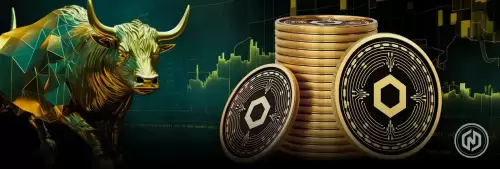 |
|
 |
|
 |
|
 |
|
 |
|
 |
|
 |
|
 |
|
 |
|
 |
|
 |
|
 |
|
 |
|
 |
|
 |
|
Cryptocurrency News Articles
Chainlink, Mastercard, and Crypto Access: A New Era of Digital Finance?
Jun 24, 2025 at 11:37 pm
Mastercard's partnerships with Chainlink and stablecoin networks signal a major shift towards mainstream crypto adoption. What does this mean for the future of finance?

The worlds of traditional finance (TradFi) and decentralized finance (DeFi) are colliding, and power players like Mastercard are leading the charge. With strategic partnerships and innovative integrations, the path to crypto access is becoming smoother for billions of users. Let's dive into the exciting developments surrounding Chainlink, Mastercard, and the evolving landscape of crypto accessibility.
Mastercard and Chainlink: Bridging the Gap
Mastercard's recent collaboration with Chainlink marks a significant step towards mainstream crypto adoption. This partnership enables Mastercard's vast network of cardholders – over three billion strong – to directly purchase crypto assets on-chain. Think about it: secure fiat-to-crypto conversions, powered by Chainlink's interoperability infrastructure and Mastercard's trusted payments network. It's a big deal.
Sergey Nazarov, Co-Founder of Chainlink, rightly points out that this is precisely the type of TradFi-DeFi convergence Chainlink was built for. By connecting Mastercard's massive user base to decentralized exchanges and on-chain trading environments, this integration unlocks unprecedented opportunities for crypto accessibility.
Stablecoins: A Key Piece of the Puzzle
Mastercard isn't stopping at Chainlink. The company is also making waves in the stablecoin arena. By joining the Global Dollar Network consortium to issue USDG and extending support to stablecoins like PYUSD (PayPal), FIUSD (Fiserv), and USDC (Circle), Mastercard is solidifying its commitment to digital assets.
Raj Dhamodharan, Executive Vice President of Blockchain & Digital Assets at Mastercard, emphasized the company's strategic approach: "If stablecoins are well-structured, well-regulated, and meet our criteria, we will enable them in various use cases." This measured approach, prioritizing security and compliance, is crucial for fostering trust and driving mainstream adoption.
X (Formerly Twitter) Enters the Fray: Crypto for the Masses?
Even social media giant X (formerly Twitter) is getting in on the action. With plans to roll out a suite of financial services, including investment, trading, payments, and even an X-branded card, the platform aims to become an 'everything app.' This includes the debut of X Money, a digital wallet and peer-to-peer payment system, starting in the US in partnership with Visa. The potential to integrate crypto trading into X's existing platform of 600 million monthly users could be transformational for crypto adoption, but trust and seamless execution are critical.
What Does This All Mean?
Mastercard's strategic moves, combined with X's ambitions, highlight a clear trend: crypto is going mainstream. The barriers to entry are coming down, thanks to innovative partnerships, stablecoin integrations, and the growing interest from major players across various industries.
However, with all of this buzz around crypto access, trust remains paramount. For example, X (formerly Twitter) has been known to have technical issues with slow loading, posts not showing up, and similar. If users don’t trust the platform with content, they’ll hesitate even more with money.
The Future is Now (and It's On-Chain)
The convergence of TradFi and DeFi is no longer a distant dream – it's happening right now. Mastercard, Chainlink, and other industry leaders are paving the way for a future where crypto access is seamless, secure, and accessible to everyone. So, buckle up, folks! The digital finance revolution is here, and it's going to be an exciting ride.
Disclaimer:info@kdj.com
The information provided is not trading advice. kdj.com does not assume any responsibility for any investments made based on the information provided in this article. Cryptocurrencies are highly volatile and it is highly recommended that you invest with caution after thorough research!
If you believe that the content used on this website infringes your copyright, please contact us immediately (info@kdj.com) and we will delete it promptly.





























































